Every business dreams of organically growing their visibility in relevant search engine results. However, the process takes a lot of time and doesn’t guarantee that you’ll see results even after a few months of hard work. That’s where search engine marketing (SEM) comes in, allowing you to boost your visibility almost instantly through pay-per-click (PPC) advertising, so your business can get ahead of the competition.
In this guide, we take a deep dive into search engine marketing campaigns to help you understand how they work and how much you can expect to spend. We also lay out x best practices to help you successfully set up your first SEM campaign.
The Complete Guide to Building a Search Engine Marketing (SEM) Campaign:
How Much Does an SEM Campaign Cost?
One of the first considerations for businesses that want to get started with search engine marketing is the cost. While you may want to spend as little as possible on your SEM campaign, it’s difficult to win ad auctions when your bids are too low. Plus, you have to consider the cost of hiring an agency to manage your PPC campaigns, which means the costs can add up.
According to WebFX, small and medium businesses typically spend $9,000 to $10,000 per month on their SEM campaigns. This investment is inclusive of the cost of SEM services from an agency.
Keep in mind that the actual costs may vary based on several factors including the number of keywords you’re targeting and the competitiveness of those keywords. Moreover, the agency’s pricing model will also have an impact on your SEM campaign cost.
While some SEM agencies charge you a flat rate for PPC management, others will charge a percentage of ad spend or ad revenue. Some may even offer capped management where you either pay a flat fee or a percentage of ad spend, whichever is higher.
For example, WebFX offers a combination of flat rate pricing and capped management for different service tiers. Their Lite plan costs $1,200 for the initial optimization along with $600 progressive monthly management cost and is suitable for businesses with an ad spend of $100-$5,000 per month. That means an ad spend of $4,500 will cost you a total of $6,300.
Meanwhile, the Pro plan costs $2,250 for initial optimization with a progressive monthly management cost of $975 or 15% of ad spend, whichever is higher. That means if your monthly ad spend is $25,000, you’ll end up spending a total of $25,000 + $2,250 + (15% of $25,000) = $31,000.
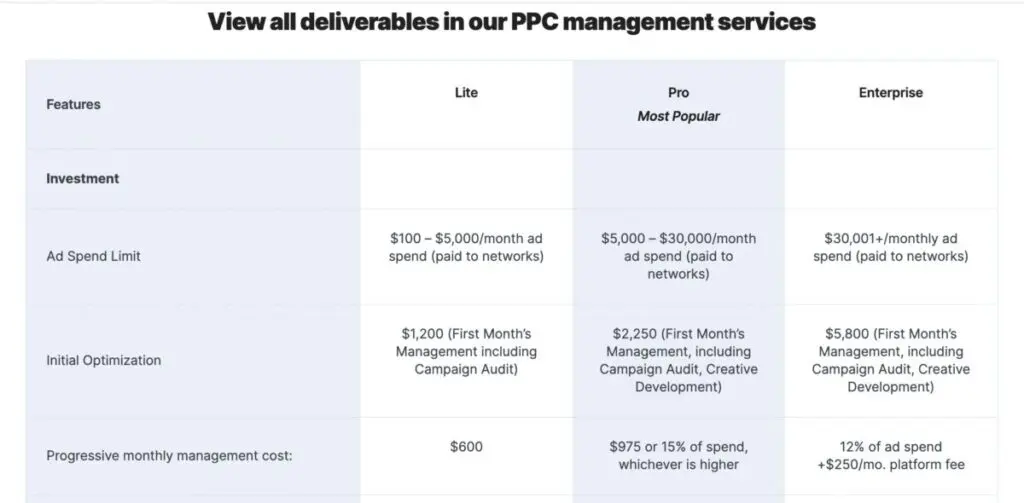
Source: webfx.com
Who Should Launch a SEM Campaign?
As effective as SEM may be, not every business is capable of running a campaign. Before you launch your campaign, make sure you tick the following boxes to see if PPC is right for your business.
- You have the time and patience to invest in SEM. Although PPC ads can deliver instant results in the form of increased visibility and traffic, it may take time to attract converting traffic. You still need to put in the hours to optimize your ads for improved conversion.
- You have the budget for ongoing management. Keep in mind that the initial investment isn’t the only cost associated with SEM. Make sure you have enough budget to continue investing in your ads.
- You’re capable of scaling. Your business has to be prepared to keep up with the increased leads and conversions coming from PPC. Whether it’s in terms of resources of resources, you should be able to quickly scale your business as you experience the positive impact of your SEM campaign.
- You have a well-optimized website. Your website should be fast and easy to navigate so the visitors coming from your PPC ads can instantly enjoy a good experience. Moreover, it should be informative to ensure that they can find the answers to their questions.
Understanding How Ad Auctions Work
To get started with your SEM campaign, you’ll need to enter into an ad auction. This ad auction is how the search engine determines which ads to show for a specific search and in which order to display them. Here’s a quick breakdown of how an ad auction works:
- When someone conducts a search, the search engine finds all the ads with keywords matching the search.
- It then eliminates any ad that isn’t eligible such as an ad targeting a different country.
- From the remaining ads, the search engine prioritizes those with a sufficiently high Ad Rank and displays them to the user.
4 Best Practices to Set Up an SEM Campaign
Based on the above, you can understand how important it is to fine-tune your targeting and choose the right keywords. Additionally, it’s important to work on improving your Ad Rank. This Ad Rank is determined by a number of factors such as your bid and your ad quality. Check out the following best practices to improve these factors and set up a successful SEM campaign.
1. Conduct Strategic Keyword Research
The keywords you choose will play a key role in the performance of your ads. You want to make sure you’re targeting keywords that will help you get your ad in front of the right audience. This will determine the subsequent ROI of your ad as people are more likely to click on ads that are relevant to their search. In the same sense, your keyword targeting will also determine the cost-effectiveness of your ad as you can ensure that your ad is displayed to only the most relevant users.
Understanding Keyword Intent
You can build an effective bidding strategy by first understanding the user intent behind different keywords. Think of whether people are just looking for information or are planning to buy something based on the keyword. For example, “how to” searches will typically be associated with users looking for information whereas searches related to “pricing” or “where to buy” will have a higher buying intent.
It's important to strategically choose which keywords to target based on the user intent that will satisfy your campaign goal. For example, if you’re just looking to raise awareness and target users at the top of the funnel, you can target the lower-intent keywords. Meanwhile, if you’re looking to quickly drive conversions, you’ll want to focus on the keywords with a higher buying intent.
See how several ads show up in the search for “email platform pricing.”
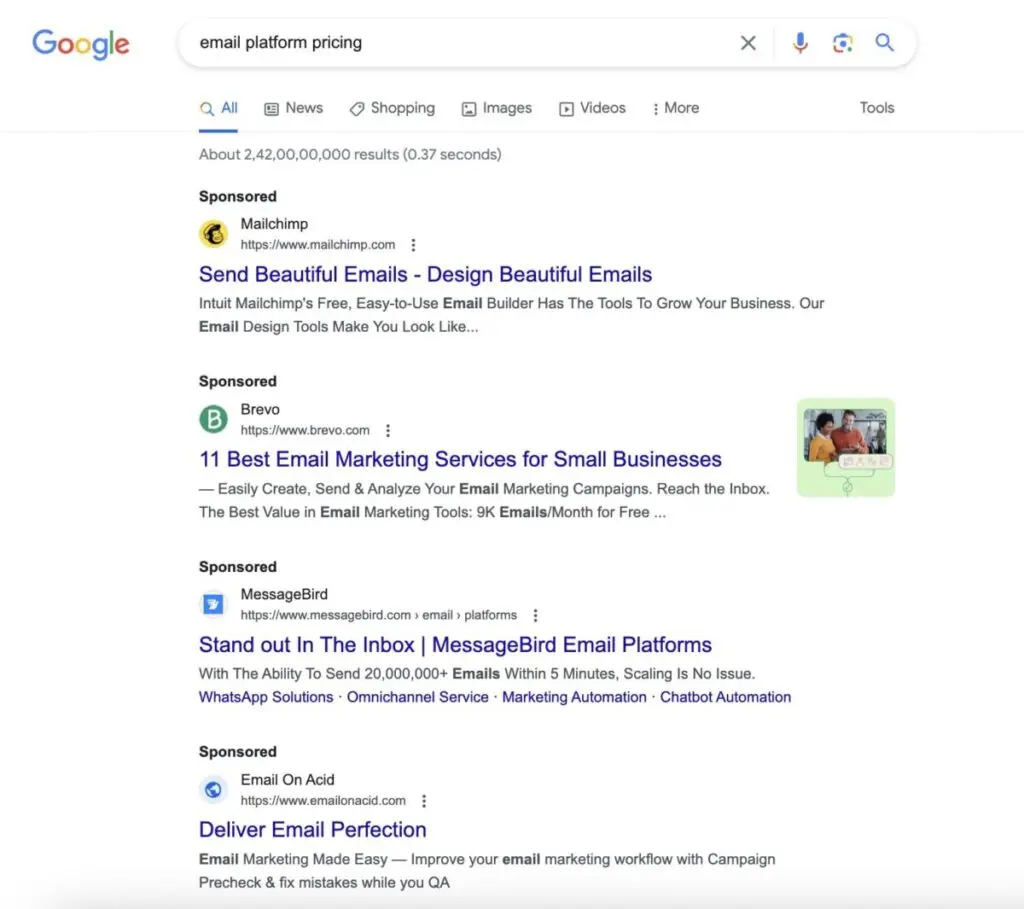
Source: google.com
On the other hand, a search for “how to use an email platform” mostly shows informative results.
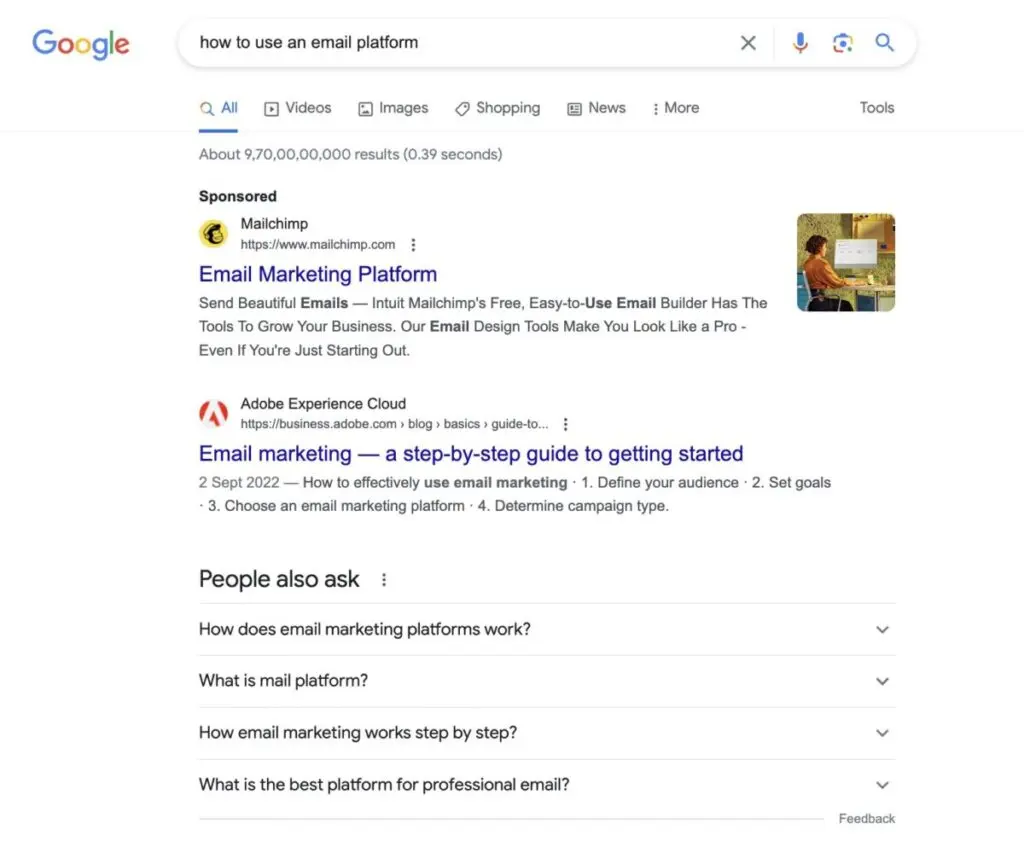
Source: google.com
Although high-intent keywords tend to cost more, they allow you to get more specific with your targeting and target users towards the end of the buying journey. This means your ads will show up in front of people who are already on the verge of making a purchase. As such, these keywords can deliver a greater ROI.
Finding the Right Balance Between Volume and Competition
Not every keyword that’s relevant to your brand will be a great addition to your SEM strategy. You also have to consider factors such as whether the keyword is getting searches and how competitive it is.
If no one is searching for the keywords in the first place, you’ll hardly get any results, no matter how relevant the terms are for your business. Alternatively, keywords that get a ton of searches tend to be highly competitive as other businesses realize the potential.
It’s important to find the right balance between keywords with a high search volume that are also low in competition. Of course, this will be a challenging feat but not at all impossible. The trick is to focus on more long-tail keywords and synonyms that are still relevant to your business but see lower competition. Consider working with an agency that offers keyword research services if you’re struggling with this.
In the following example, the exact keyword we provide “meal delivery” sees significantly high searches but is also highly competitive. So you may want to focus on the low competition keywords like “food delivery near me” or “healthy meal near me” as these long-tail keywords also have a high monthly search volume. Alternatively, “food deliveries” could be another keyword to target as it sees medium competition and a high volume of searches each month.
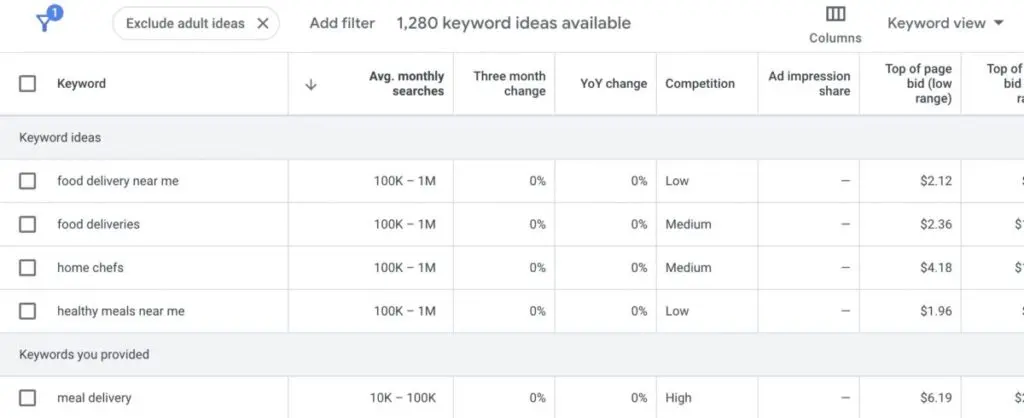
Source: accounts.google.com
Keeping Keyword Cost in Mind
It’s also important to keep keyword cost in mind when developing your bidding strategy. Your bid is one of the main factors that search engines will consider when determining your ad placement. Higher offers will naturally be prioritized and placed more prominently than ads with a lower offer.
That also means that if you’re bidding too low, there’s a chance your ad will not show up. As such, you’ll want to strategically choose keywords considering the subsequent cost. High-competition keywords will end up costing a lot more, although they have the potential to generate a higher return.
This is why you need to strategically target only the most important keywords for your business. If you’re working with a smaller budget, you may want to focus on high-intent transaction keywords so your ads will show up in front of people who are already ripe for conversion.
2. Plan Your Campaign Structure
Displaying the same ad for all your keywords may seem like an easy way out. But you’re going to end up with generic, low-quality ads that cost a lot to manage. This is why account and campaign structuring should be a priority when setting up an SEM campaign. It not only makes it easier to manage your campaigns but also helps you deliver more relevant ads for specific search terms.
You may organize your campaign into the following levels:
- Campaign – This is the highest level that will house different keywords and ad groups. Your ad categories are divided into different campaigns such as end-of-season sales, returning customers, competitor searches, and so on.
- Ad group – An ad group contains a set of keywords, offers, or products centered around the same theme. It’s essentially a subcategory or segment within the primary category i.e., your campaign. For example, a campaign to promote outdoor gear may have an ad group for camping equipment and another ad group for trekking gear.
- Keywords – These are the queries that you’re bidding on for each ad group. For example, under the camping equipment ad group, you may bid on keywords such as sleeping bags, sleeping bag liner, sleeping tent, camping kitchen, and so on.
- Ad – Finally, you have the ad, which is the copy that’s displayed in the sponsored results when people search for your chosen keywords. If you have a separate ad for each ad group, you can effectively display copy that’s highly relevant to the user’s specific search. For example, someone searching for keywords related to camping equipment will see a different ad than someone searching for keywords related to trekking gear.
3. Craft Compelling Copy
Your ad copy is what people see when they search for the keywords you’re bidding on. As such, it’s the very thing that entices them to click. So you need to create powerful copy that will help you earn those clicks.
First of all, your ad copy should be relevant to the keywords you’re targeting. In other words, people seeing your ad should be able to see an offer that aligns with what they’re searching for. This is important because ad relevance is an important factor that affects your ad Quality Score, which will subsequently influence your ad placement. Here are a few best practices to help you create compelling ad copy:
- Make sure you’re presenting a real offer. That means, if your ad copy is offering a 50% discount, you should actually be offering a 50% discount.
- The copy should be free of typos and spammy symbols.
- Keep it concise and direct. You can include up to 30 characters per headline and 90 characters per description. So say exactly what you need to say to avoid using up all the space with unnecessary information.
- Include a clear call-to-action to encourage people to click.
- Test different variations to see what resonates best with your audience.
Here’s an example of compelling ad copy from Intuit Mailchimp. The title tells you exactly what you can do i.e., design beautiful emails. The description encourages you to “send beautiful emails” and briefly explains some of the perks of using the email builder.

Source: google.com
4. Create Optimized Landing Pages
Your SEM campaign doesn’t just stop at creating ads. You also need to plan for what happens after people click on your ads.
The first thing they’ll see after that initial click is your landing page, so it needs to match what you’re promoting in the ad. That means if you promoted an end-of-season sale in the ad, it should lead to a landing page with products that are part of the sale.
Additionally, you should use similar language to seamlessly connect their experience. In other words, you need an optimized landing page to build a smooth transition from discovering the product to buying it.
For example, when you click on the above Intuit Mailchimp ad, it takes you to the following landing page. Here, the landing page talks about taking your email marketing to the next level and boosting your ROI. This aligns with the ad copy that discusses how the email builder offers tools to grow your business.
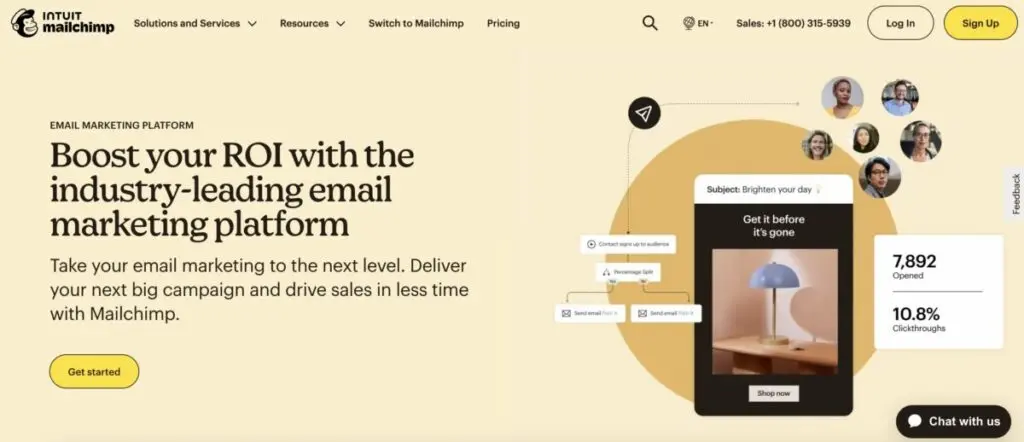
Source: mailchimp.com
Next Steps: Track, Measure, Optimize
Your SEM campaign isn’t guaranteed to deliver impressive results from the get-go. It takes a bit of trial and error to figure out how to launch successful PPC ads that drive conversions. So you need to keep track of your campaign, test different ad variations, measure results, and optimize your ads for improved performance.
Frequently Asked Questions
What is an SEM campaign?
An SEM campaign or a search engine marketing campaign is a strategy to improve your brand visibility in search engines through paid ads.
What is the difference between SEO and SEM?
SEO refers to the organic methods of boosting your website visibility whereas SEM encompasses both organic and paid methods to boost your site visibility.
Is SEM and PPC the same?
SEM is an umbrella term that includes the use of PPC but is not limited to just PPC advertising.
Can SEM improve SEO?
Yes, SEM can contribute positively to your SEO efforts by bringing quality traffic and providing you with insights to optimize your strategy.
How much does an SEM campaign cost?
According to WebFX, an SEM campaign for SMBs typically costs between $9,000 and $10,000 per month.






